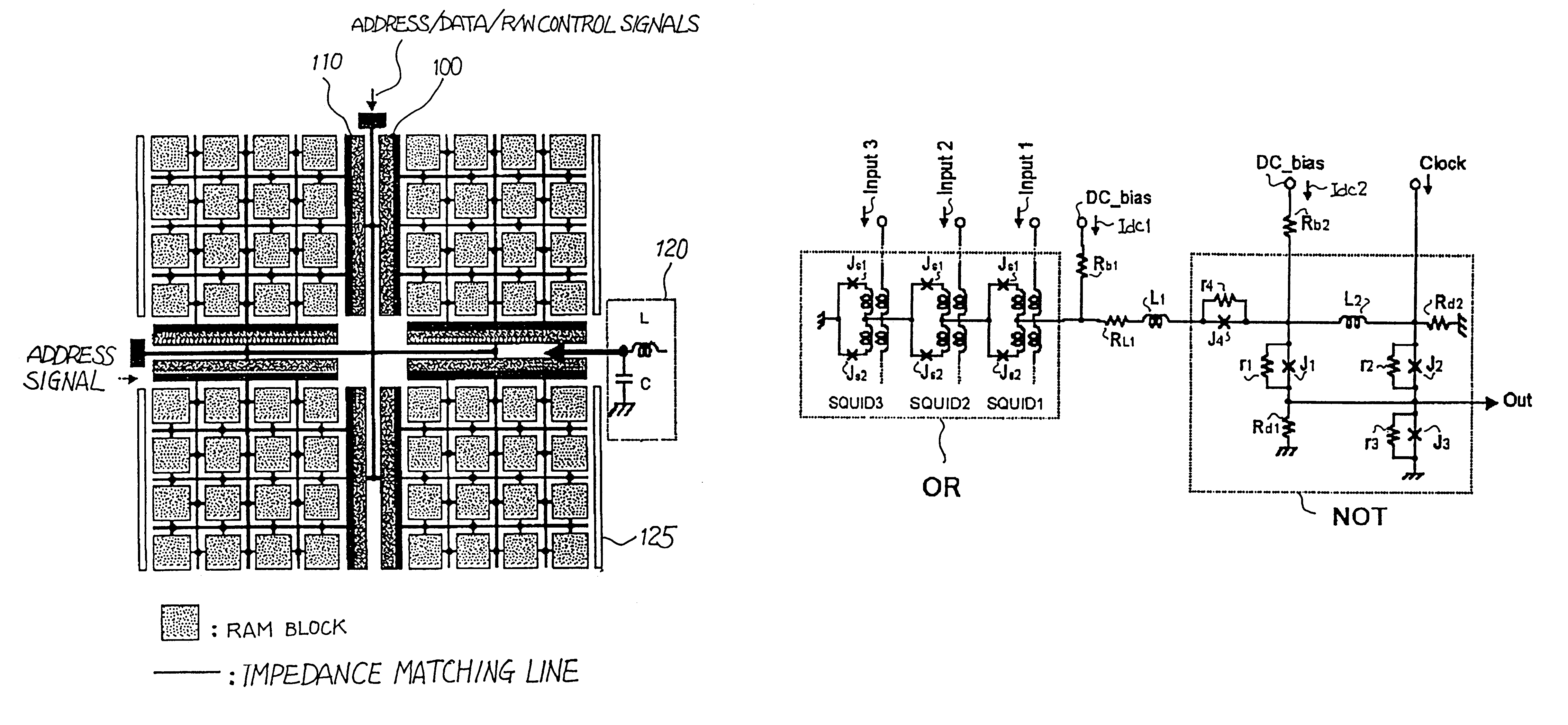Superconducting circuit having superconductive circuit device of voltage-type logic and superconductive circuit device of fluxoid-type logic device selectively used therein
- Summary
- Abstract
- Description
- Claims
- Application Information
AI Technical Summary
Problems solved by technology
Method used
Image
Examples
second embodiment
FIG. 7 illustrates a superconducting NOR gate embodying the present invention. The superconducting NOR circuit comprises a magnetically coupled multi-input superconducting OR circuit OR, a superconducting NOT circuit NOT, bias feed resistors Rb1 / Rb2, a load resistor RL1 and an inductor L1. The superconducting OR gate OR is connected through the bias feed resistor Rb1 to a source of direct bias current, and the superconducting NOT circuit NOT is connected through the bias feed resistor Rb2 to the source of direct bias current. The source of direct bias current supplies direct bias current Idc1 to the superconducting OR circuit OR and direct bias current Idc2 to the superconducting NOT circuit NOT.
The superconducting OR circuit OR includes superconducting quantum interference devices SQUID1 / SQUID2 / SQUID3, and the superconducting quantum interference devices SQUID1 / SQUID2 / SQUID3 are coupled in series between the load resistor RL1 and the ground. The superconducting quantum interference...
third embodiment
FIG. 9 illustrates a superconducting decoder circuit embodying the present invention. The superconducting decoder circuit comprises eight superconducting NOR circuits 200 / 210 / 220 / 230 / 240 / 250 / 260 / 270, superconducting driver circuits 280 and terminating resistors 290, and, accordingly, eight superconducting OR circuits SFQ_OR and eight superconducting NOT circuits SFQ_NOT form the superconducting NOR circuits 200 to 270 as similar to the superconducting NOR circuit shown in FIG. 7.
All the superconducting NOR circuits 200 to 270 are biased with direct current, and all the superconducting driver circuits 280 are biased with alternating current. Thus, the superconducting NOR circuits 200 to 270 are constituted by the SFQ devices, and the superconducting driver circuits 280 are constituted by the latching devices. A three-bit address signal A / B / C and inverted address bits CA / CB / CC are supplied to the driver circuits 280, and the driver circuits 280 are selectively connected to the superco...
fourth embodiment
FIG. 10 illustrates a superconducting signal converting circuit embodying the present invention. The superconducting signal converting circuit comprises Josephson junctions J1 / J2 / J3, damping resistors Rd1 / Rd2, an inductor L1 and bias feed resistors Rb1 / Rb2. The series combination of the inductor L1, the Josephson junction J3 and the damping resistor Rd2 is connected between an input node and the ground, and an input signal In is supplied to the input node. The input signal is SFQ pulses. Although the damping resistor Rd2 is grounded at one end thereof, the grounded end serves as an output node, which is connected to an input node of the next stage. An output signal Out is obtained at the output node, and is a level signal.
A source DC of direct bias current is connected to the bias feed resistor Rb1, and direct bias current Idc flows from the source DC through the bias feed resistor Rb1 to the parallel combination of the damping resistor Rd1 and the Josephson junction J1. The paralle...
PUM
 Login to View More
Login to View More Abstract
Description
Claims
Application Information
 Login to View More
Login to View More - R&D
- Intellectual Property
- Life Sciences
- Materials
- Tech Scout
- Unparalleled Data Quality
- Higher Quality Content
- 60% Fewer Hallucinations
Browse by: Latest US Patents, China's latest patents, Technical Efficacy Thesaurus, Application Domain, Technology Topic, Popular Technical Reports.
© 2025 PatSnap. All rights reserved.Legal|Privacy policy|Modern Slavery Act Transparency Statement|Sitemap|About US| Contact US: help@patsnap.com



